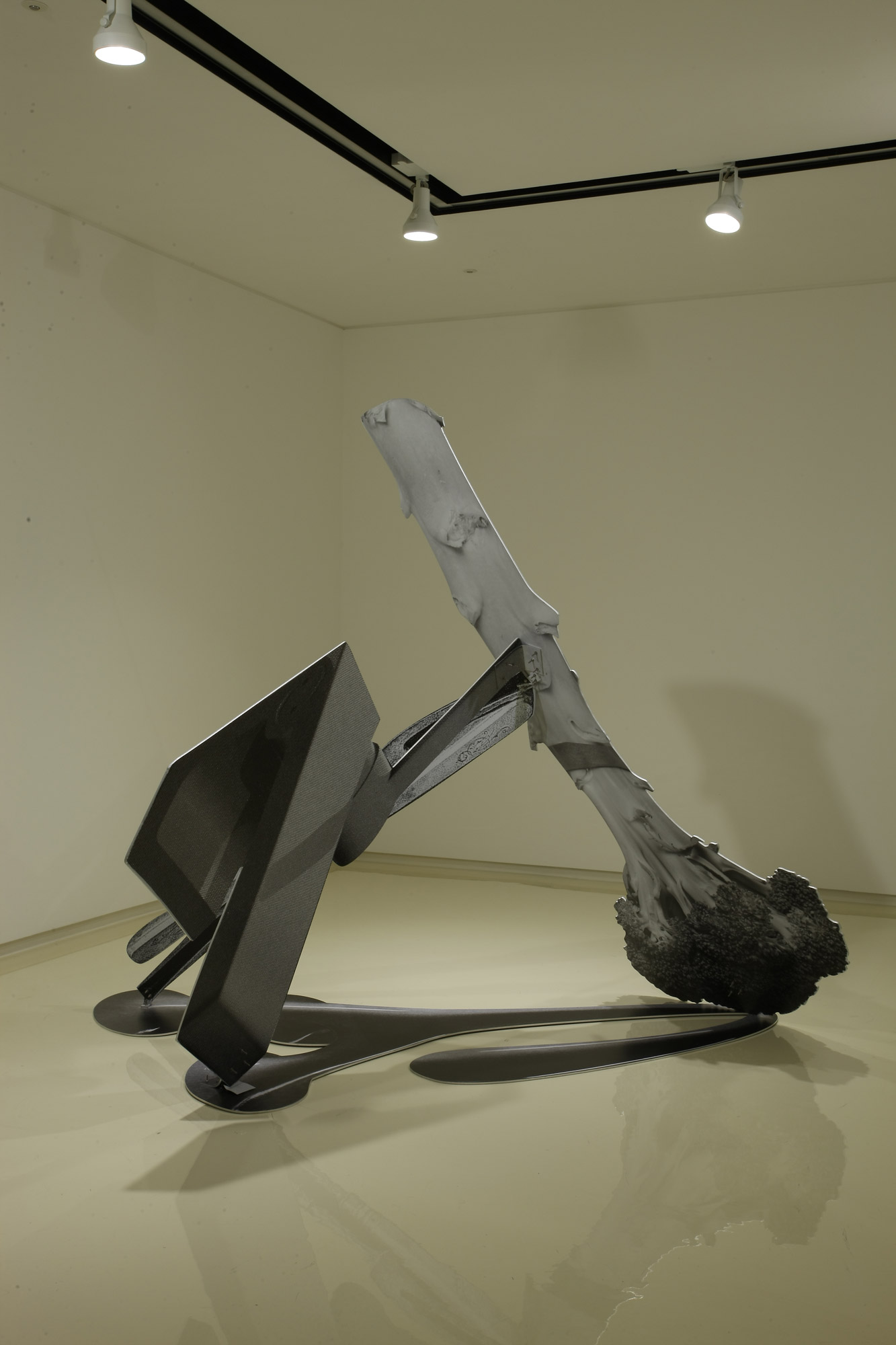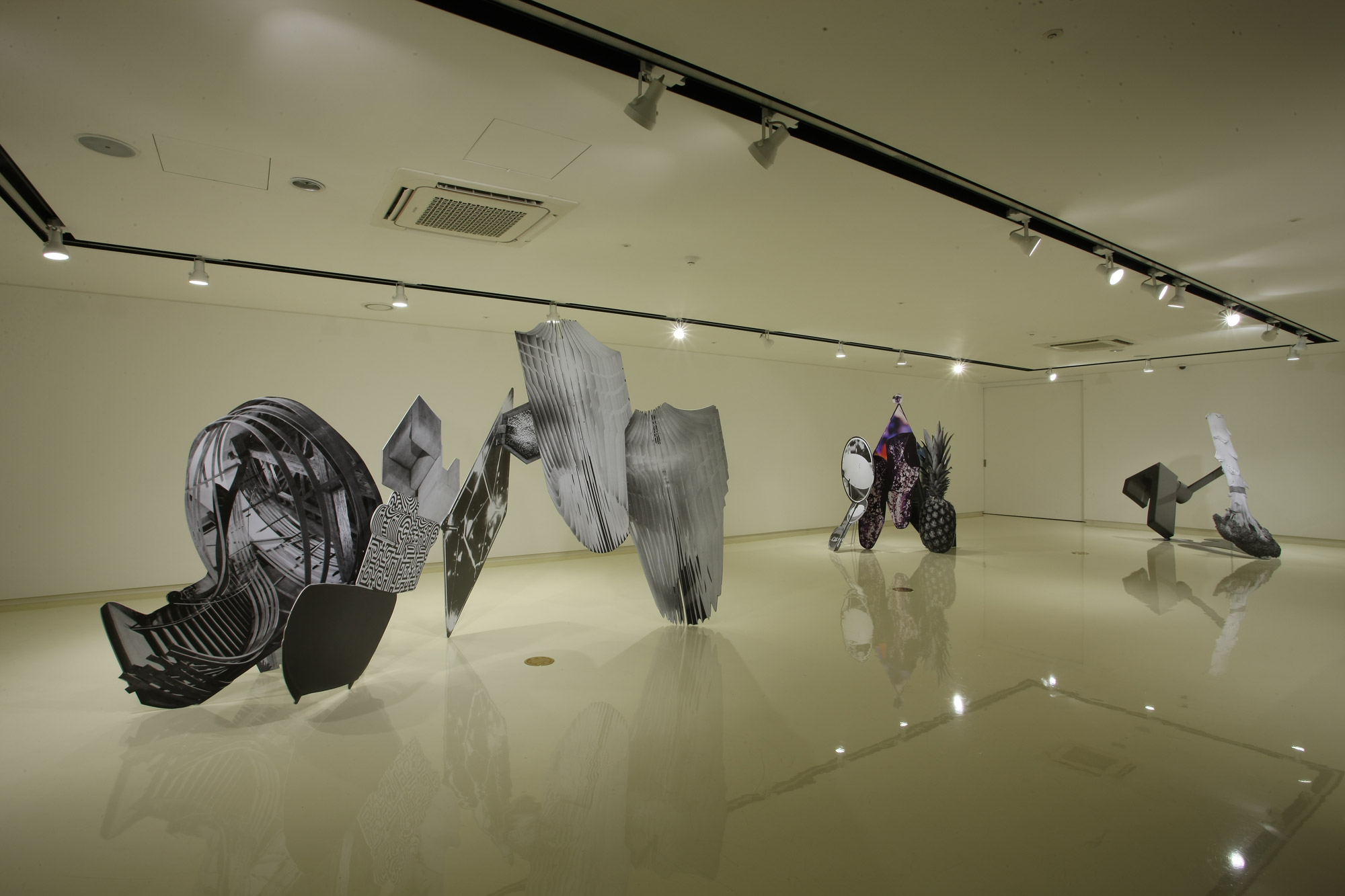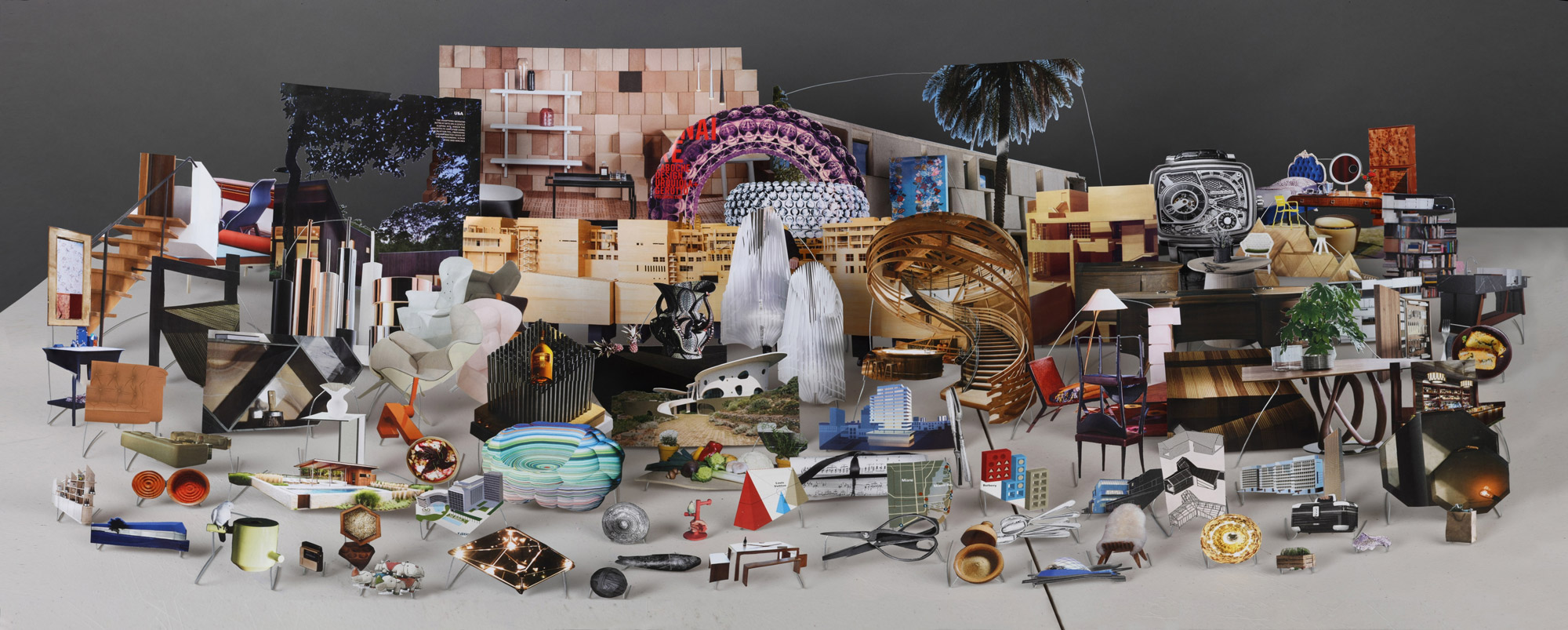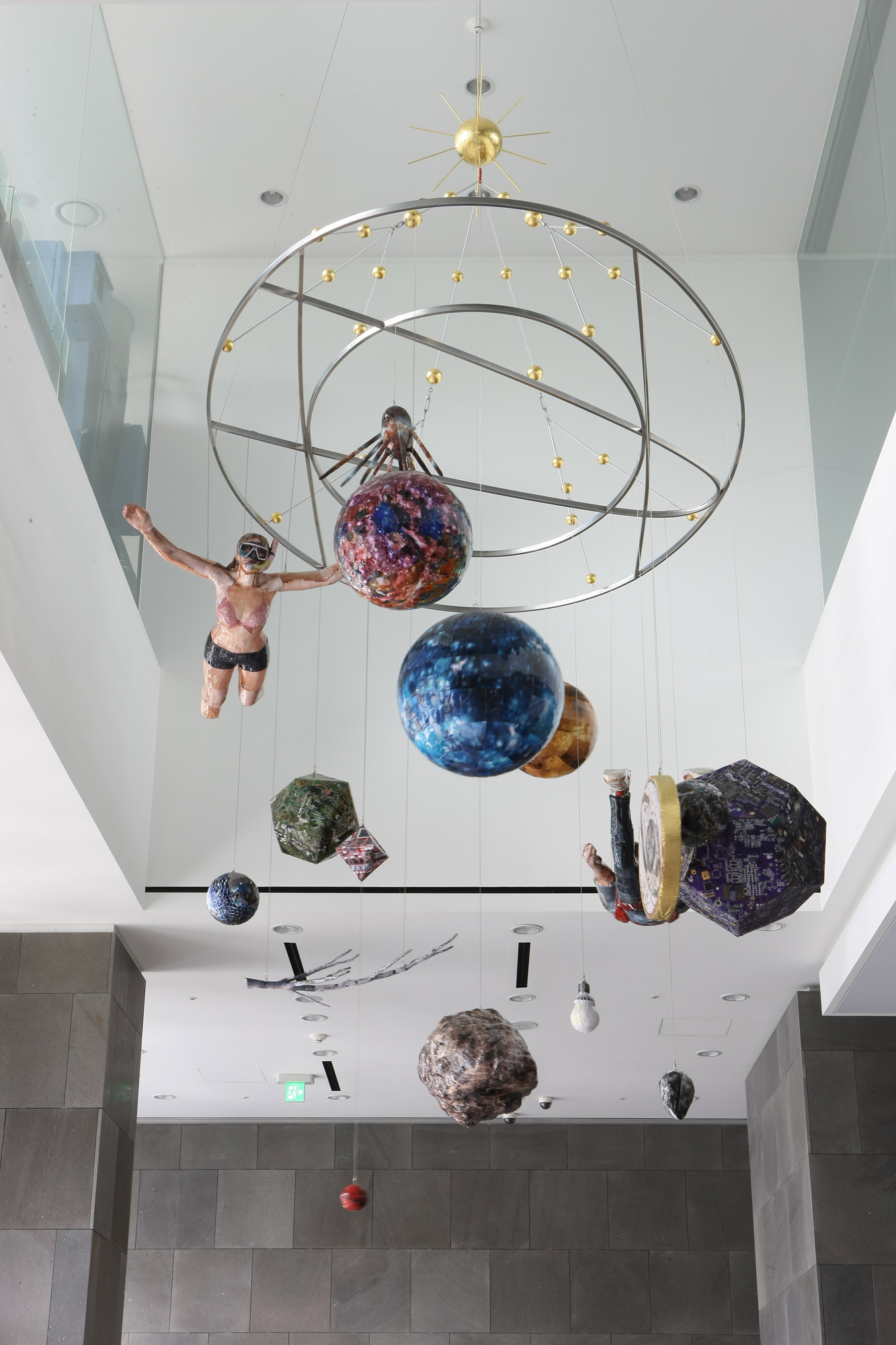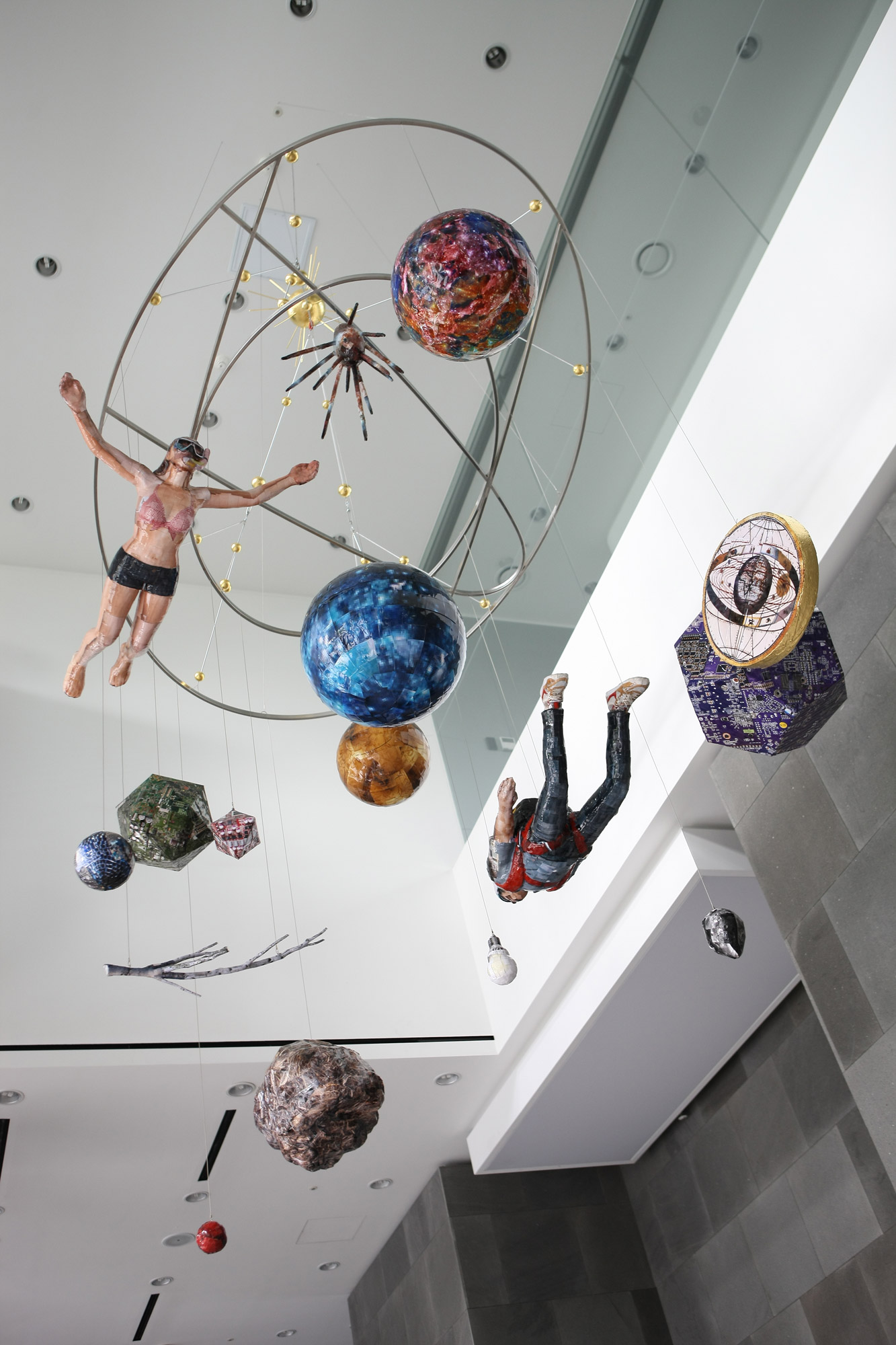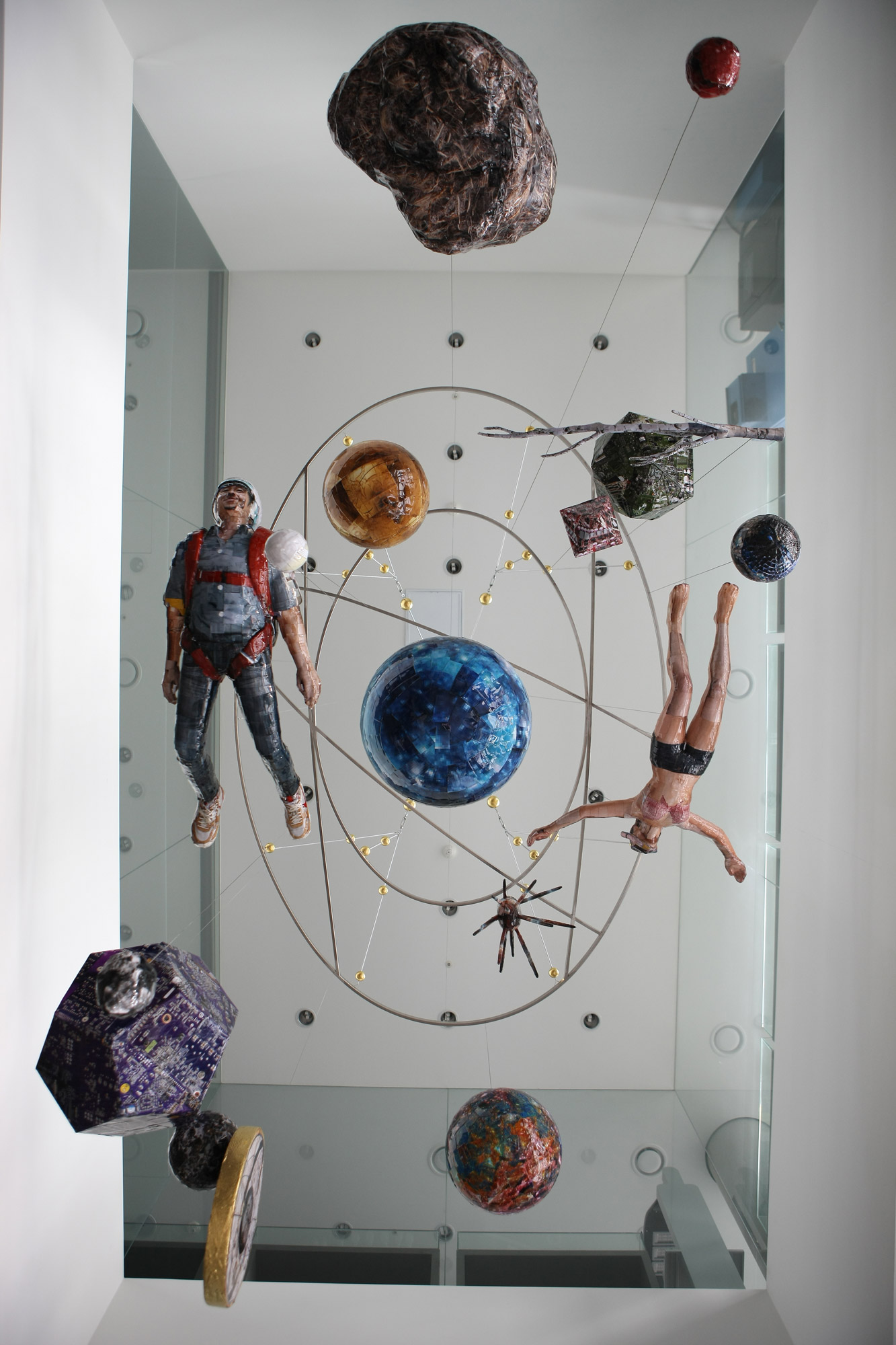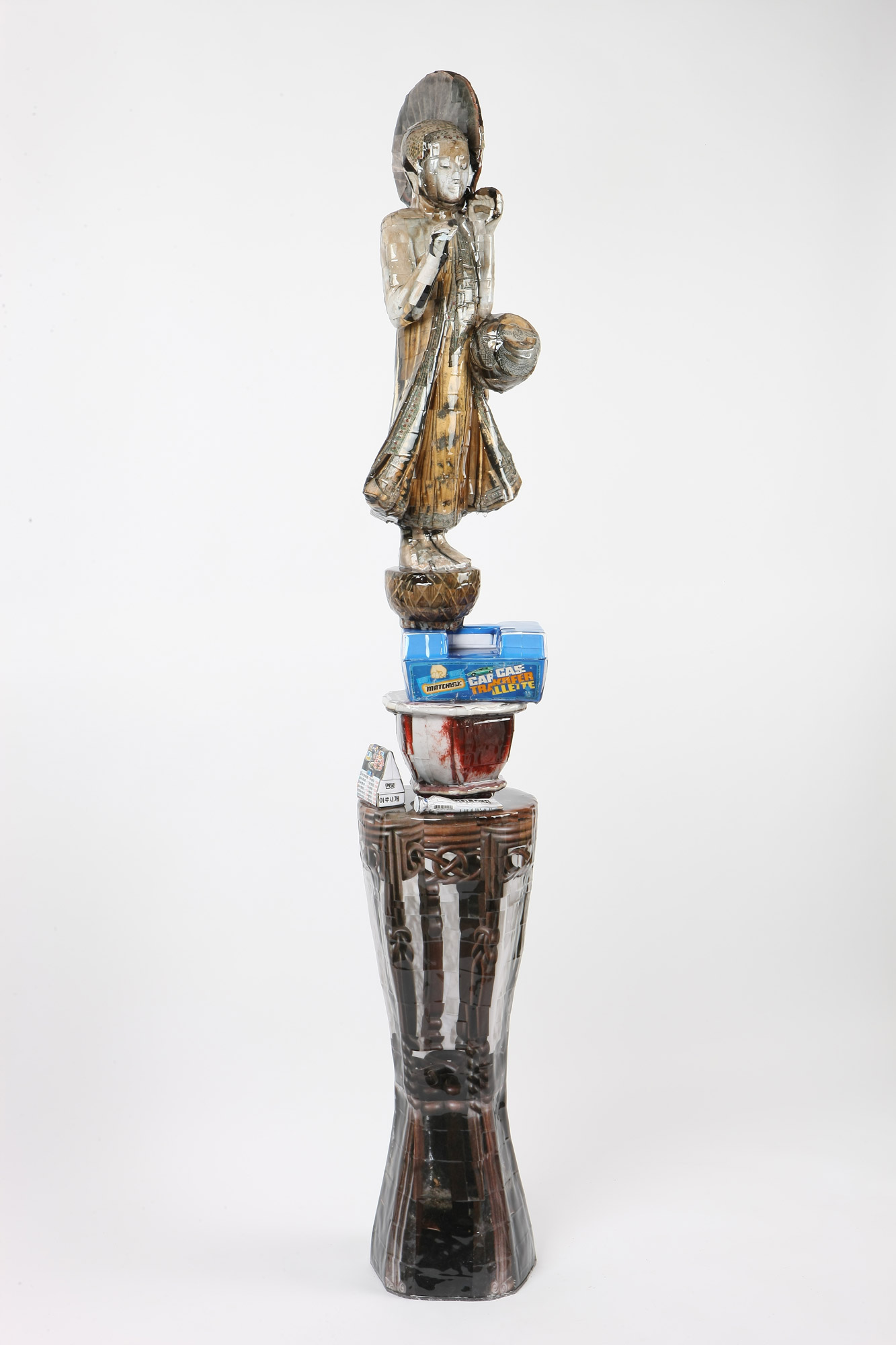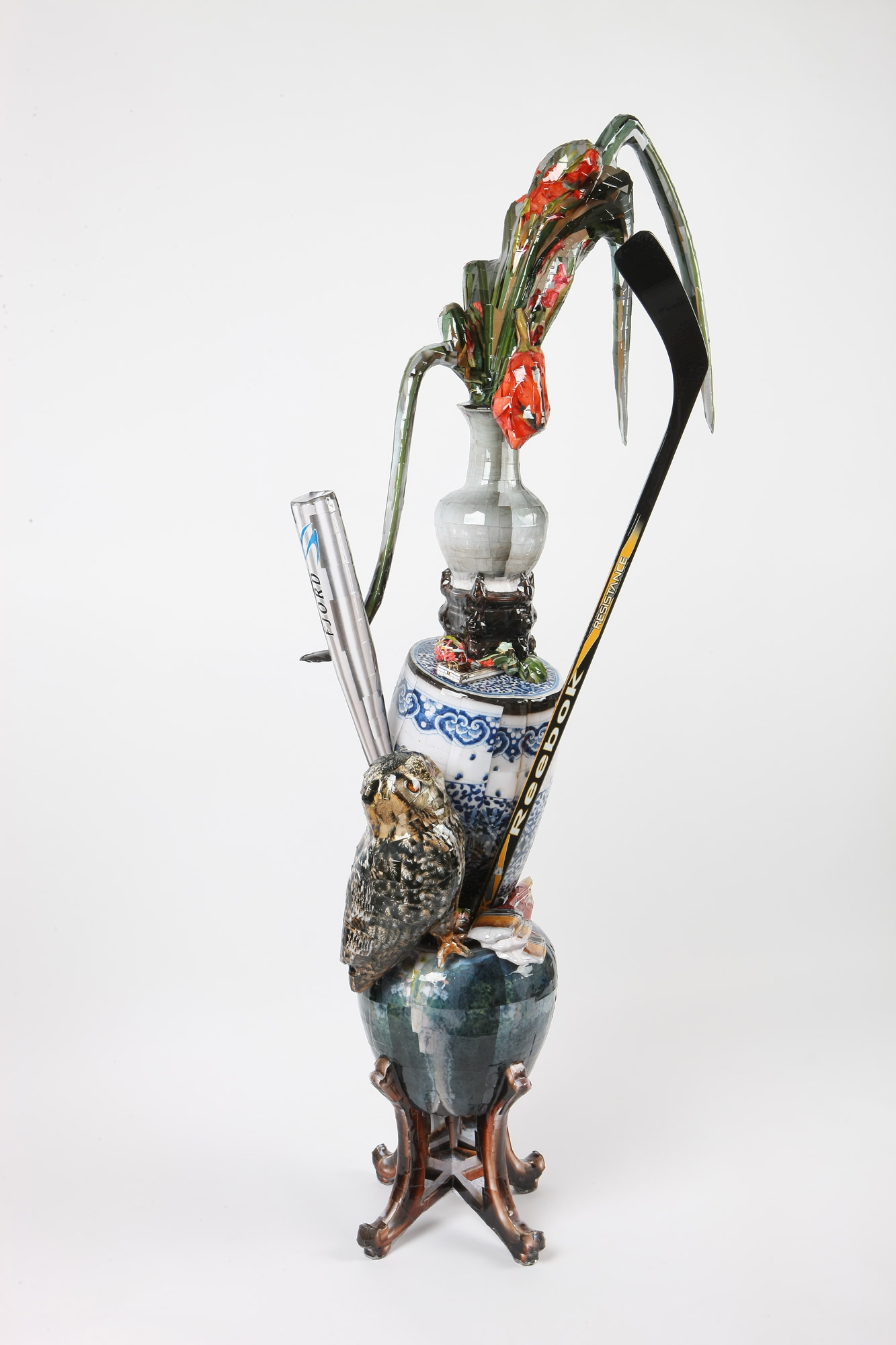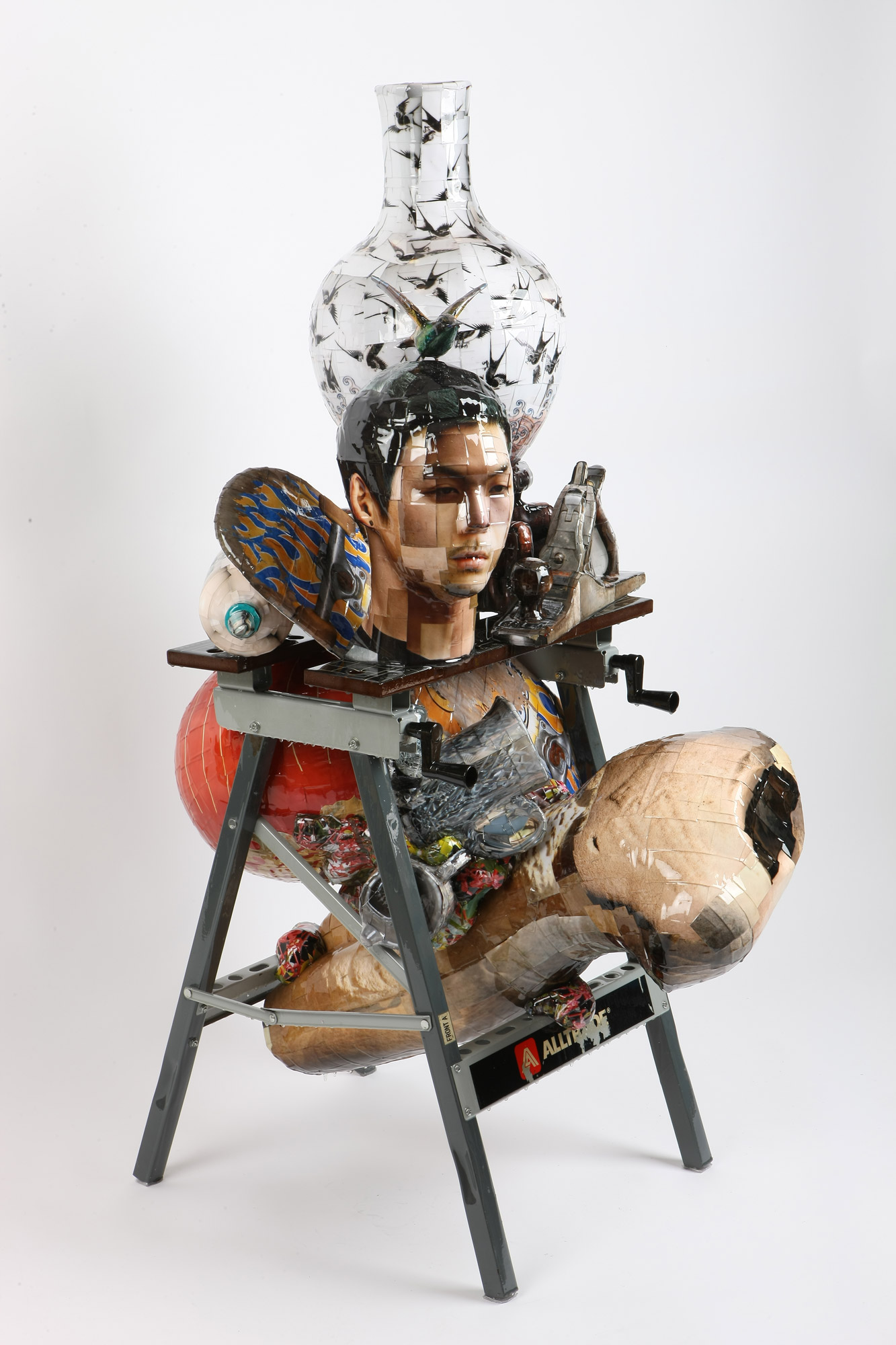Exhibitions

PERIGEE ARTIST #2 권오상
Structure
2014.06.12. THU ~
2014.11.08. SAT
이미지의 기술_The Art of Image
신승오(페리지 갤러리 디렉터)
권오상의 대표적인 작품 시리즈는 3가지로 [Deodorant Type], [The Flat], [The sculpture] 이다. 각각의 시리즈들은 형식은 다르지만 서로에게 영향을 끼치면서 진행되어 왔다. 이번 전시에서는 [Structure]라는 타이틀 아래 최근에 선보이고 있는 [Masspatterns]시리즈와 [New Structure]시리즈의 새로운 연작들을 볼 수 있다. 이들 시리즈는 전시의 타이틀인 구조에 대한 이야기를 어떻게 작가가 풀어나가고 있는지 그리고 왜 이러한 주제를 선택하였는지 궁금증을 유발한다. 따라서 우리에게는 권오상의 작품을 지금까지 해왔던 대표적인 작업에서부터 이번 신작들까지 살펴보면서 형식과 내용적인 변화의 흐름을 살펴보는 것이 그의 작업을 이해하는데 도움이 될 것이다.
먼저 형식적인 부분에 대해서 살펴보자. 권오상 작가의 특징 중에 하나는 조각이라는 장르에서 벗어나지 않고 지속적으로 작업을 해오고 있다는 점이다. 그러나 사진을 활용한 [Deodorant Type]과 [The Flat]이 대표적인 작업이어서 가끔은 그가 조각가라는 사실을 망각하는 경우가 있다. 물론 컨템포러리 아트에서 이러한 장르적 구분은 무의미하지만, 권오상은 조각의 언어에 대한 지속적인 연구를 해오고 있는 작가임에는 틀림이 없고, 작가 스스로도 조각가 임을 부정한 적이 없다. 그렇다면 무엇이 그....
The Art of Image
By Shin Seung-oh, Perigee Gallery Director
Osang Gwon has three major bodies of work; <Deodorant Type>, <The Flat>, and <The sculpture>. While each of the series comes in different forms, there’s been much interaction between the series in their development process. Under the show title <Structure>, we will be able to see in this show new groups of work from the recent <Masspatterns> series and <New Structure> series. These series raise interest on how the artist wheels out the narrative of the show’s namesake “structure”, and also why this particular subject was selected by the artist. Hence it would help us understand his work if we were to examine the flow of changes that occur in the forms and contents of Osang Gwon’s artwork, from the most renowned pieces of his career to his newest work for the show.
Let us first examine the formal aspects. One of the characteristics of Osang Gwon is that his work has always stayed within the discipline of sculpture. Yet owing to the fact that <Deodorant Type> and <The Flat> series which both utilize ....
신승오(페리지 갤러리 디렉터)
권오상의 대표적인 작품 시리즈는 3가지로 [Deodorant Type], [The Flat], [The sculpture] 이다. 각각의 시리즈들은 형식은 다르지만 서로에게 영향을 끼치면서 진행되어 왔다. 이번 전시에서는 [Structure]라는 타이틀 아래 최근에 선보이고 있는 [Masspatterns]시리즈와 [New Structure]시리즈의 새로운 연작들을 볼 수 있다. 이들 시리즈는 전시의 타이틀인 구조에 대한 이야기를 어떻게 작가가 풀어나가고 있는지 그리고 왜 이러한 주제를 선택하였는지 궁금증을 유발한다. 따라서 우리에게는 권오상의 작품을 지금까지 해왔던 대표적인 작업에서부터 이번 신작들까지 살펴보면서 형식과 내용적인 변화의 흐름을 살펴보는 것이 그의 작업을 이해하는데 도움이 될 것이다.
먼저 형식적인 부분에 대해서 살펴보자. 권오상 작가의 특징 중에 하나는 조각이라는 장르에서 벗어나지 않고 지속적으로 작업을 해오고 있다는 점이다. 그러나 사진을 활용한 [Deodorant Type]과 [The Flat]이 대표적인 작업이어서 가끔은 그가 조각가라는 사실을 망각하는 경우가 있다. 물론 컨템포러리 아트에서 이러한 장르적 구분은 무의미하지만, 권오상은 조각의 언어에 대한 지속적인 연구를 해오고 있는 작가임에는 틀림이 없고, 작가 스스로도 조각가 임을 부정한 적이 없다. 그렇다면 무엇이 그를 사진조각가로 칭하게 하였는지 짧게 살펴보도록 하자. 권오상 작업의 가장 기본적인 물성인 사진은 조각이 가지고 있는 입체성에 대한 반증으로 [The Flat]과 [Deodorant Type]에서 보이듯이 평면적인 매체를 가지고 입체의 형태를 만들어 내는 것이다. 실제의 대상을 눈을 통해 인지하고 다시 입체로 만들어지는 과정 속에서 변해가는 형태들, 실제로 인지할 수 없는 세밀한 부분들을 평면의 사진을 통해서 분할하여 재구성한 3D는 실제와 어떻게 다르게 재현되는지 우리에게 보여준다. 그리고 이와 함께 발생하는 그의 작품의 또 다른 속성인 가벼운 조각은 또 다른 권오상 작업의 특징으로 덩어리의 무게가 주는 감성들과는 반대되는 가벼움이라는 이중적 속성이 한 작업 안에 공존한다. [The Flat]시리즈는 이미지들을 잡지에서 찢어내어 철사로 만든 틀에 붙여 실제 오브제인 것처럼 새우고 다시 사진으로 찍어 실제의 물건인 것처럼 평면으로 뽑아낸다. 이 작업 역시 실제를 더욱 실제와 같이 생생하게 만드는 광고 사진의 특성을 이용한, 2D와 3D의 경계를 모호하게 하는 작업이다. 이와는 조금 다른 시리즈로 보이는 [The Sculpture]는 인위적인 손맛을 과도하게 표현하고 조각적인 재료를 사용하여 작가의 행위와 물성자체를 드러내고자 하는 것처럼 보이지만, 결국 실제의 대상을 직접 보고 만들어낸 것이 아닌 여러 이미지들의 조합을 통해 만들진 이전 작업과 연장선상에 있는 작업이다. 이러한 작업들에서 우리는 입체를 다루는 관점에서 평면적 재료인 사진과 이미지들을 사용하는 권오상의 작업태도를 충분히 살펴볼 수 있다. 그리고 그는 조각 언어라는 지속적인 틀 안에서 조각이 가지고 있는 특성과 한계, 사진의 재현에 대한 연구들을 통하여 미술에 있어서의 재현이라는 문제를 다루고 있음을 알 수 있다.
그렇다면 이번에는 이번 전시에서 선보이는 [Masspatterns]와 [New Structure]을 살펴보자. 이 작품들은 덩어리를 구축하는 방식과 평면을 구조물로 만드는 좀 더 복잡한 형태의 과정을 드러낸다. 먼저 [Masspatterns]는 기존의 [Deodorant Type]과는 다르게 실제의 오브제들이 사진조각 사이에 불규칙적으로 들어가 우리가 쉽게 이들을 구분하지 못하게 만든다. 그리고 이러한 덩어리들은 기존의 작업들처럼 미술사에 도상학적으로 나타나는 구성을 가지고 있지 않으며, 말 그대로 즉흥적으로 작가의 의도에 의해 덩어리들을 뭉쳐서 새로운 형태로 나타난다. 사진을 통한 재현과 실제 오브제의 조합은 재현과 실제 사이의 구축적인 오브제 쌓기 방식으로 실재와 재현의 간격을 없애버리면서 다시 한번 그 경계를 모호하게 만들고 있다. 이러한 작업 중에 눈에 띄는 작품은 칼더의 모빌을 차용한 작업이다. 칼더는 모빌이라는 자연의 흐름에 의한 불규칙적인 움직임을 가진 작업으로 시간과 색채와 물성에 대한 연구를 통해 관습적인 조각언어에서 벗어나 새로운 예술개념을 만들어 냈다. 그리고 끝없는 우연적인 운동을 통해 사건이 연속으로 끝없이 움직이는 세상을 단순한 색, 면, 선으로 이루어진 추상의 우주로 표현하였다. 반면에 권오상은 기존의 사진작업에서 벗어나 온라인 상에서 우리가 쉽게 접할 수 있는 넘쳐나는 이미지와 현재 우리 사회에 관한 다양한 지표들을 수집하여 이미지로 채워진 구상의 우주를 만들어 냈다. 그리고 이를 [Massmobile]이라 명명하였다. [Massmobile]은 사실 구상적인 형태를 가지고 있지만, 그것의 표면은 추상적인 이미지로 채워진 [Masspatterns]의 덩어리들이 공간에 균형을 이루면서 마치 샹들리에처럼 나타나며, 이렇게 추상과 구상, 2D와 3D가 뒤섞인 그의 작업은 다양한 변화 가능성으로 가득 찬 공간이자 구조로 확장되고 있다. 결국 작가는 대상을 바라보는 주체인 나의 관점과 시각에 의해 세상이 변화된다는 ‘나’의 주체성을 강조하고, 칼더와 다르게 비결정적이고 우연적인 세상이 아니라 ‘나’에 의해 만들어지는 즉물적이고 현실적인 세상의 모습을 효과적으로 표현해 내고 있다. 이를 통해 작가는 자신이 바라보고 있는 현대사회의 구조와 세계관을 우리에게 보여준다. 한편 이러한 권오상의 [Masspatterns]와 모빌 작업에서 보이는 구축적인 형태와 구성은 작가의 구조적인 것에 대한 관심의 시작점으로 보인다.
그의 이러한 새로운 관심은 또 다른 칼더의 작업인 스테빌을 차용한 [New Structure]시리즈에서 잘 드러난다. 이 시리즈는 그가 지속적으로 진행하고 있는 이미지의 허상에 대한 실체적인 구현으로 더욱 복잡한 구조로 나아간 작업이다. 칼더의 이러한 조형작업들은 칼더 이후에도 후대 작가들에 의해 지속적으로 조형적인 연구가 이루어졌지만, 더 이상 새로운 모습을 보이지 못하고 그 한계를 보였었다. 그러나 권오상의 [New Structure] 시리즈는 조형적인 형태를 이미지가 가지고 있는 조형을 그대로 잘라 사용하여 구조를 만들어 낸다는 점, 구조를 가질 수 없는 2D의 이미지를 구조적 조형으로 만들어 내는 점이 이전 세대의 작업들과 확연히 구분된다. 그리고 [New Structure]에서 그가 사용하고 있는 이미지는 기존의 자신의 [The Flat] 시리즈에 등장하는 이미지들로 이를 평면 밖으로 들고 나와 재구성하여 평면으로 이루어진 구조물로 만들어 놓는 점이 흥미로운 작업이다. 이는 양면에 같은 이미지로 이루어진 양감이 없는 평면들이 다시 서로에게 얽혀져서 얇은 유기적인 구조물로 존재하고, 대상을 바라보는 방향에 따라 다양한 시각적인 변화를 보여준다. 칼더와 그 후대의 작업들이 굳건하게 대지에 다리를 내려 단단하게 고정되어있고 색 면과 조형적 형태의 결합을 통한 유기적이고, 비정형적인 형태의 조형미를 가졌다면, 권오상의 [New Structure]는 비정형적인 형태뿐만이 아니라 이미지와 이미지가 가지고 있는 조형 형태를 바탕으로 쌓아가며, 이미지들이 중첩됨으로써 구축적인 모습이 한층 강조되어 있고, 이러한 조형성과 이미지에 의해 가볍게 공간에 존재한다. 또한 자신의 기존의 작품에서 만들어낸 이미지를 다시 차용하여 구조물로 실제의 공간에 존재하게 함으로써 자신이 만들어낸 환영과 실재의 경계를 역의 역으로 변화시키고, 이미지를 구조화하여 처음 잡지에서 오려낸 이미지, 그리고 [The Flat]작업에서의 나타나는 이미지와는 다른 자연스러운 유기적 형태를 드러내고 있다.
그렇다면 권오상은 왜 이미지를 가지고 다양한 차원을 넘나드는 작업을 하고 있는 것일까? 권오상의 작업은 반짝이고 화려한 이미지와 외형으로 다가오지만, 자세히 살펴보면 다루는 대상이 거창하지 않고 소박하다. 사실 그가 작업에서 담고 있는 이미지들은 모두 작가의 주변 사람이거나, 우리가 흔하게 볼 수 있는 잡지의 이미지, 작가의 작업실에 흔히 있는 공구들, 그리고 자신이 다니면서 자주 보고, 사용하고, 수집한 물건 들이다. 최근에는 온라인을 통해서 무형의 공간을 떠도는 이미지들을 수집하여 특별한 가공의 과정 없이 픽셀이 보이고 완벽하지 않은 이미지도 그대로 작업에 사용한다. 그리고 특히 이번 작업에서는 자신의 작업에 이미 사용된 작품 속 이미지를 재사용함으로써 점점 이미지의 활용법과 방식의 영역이 넓어져 가고 있다. 권오상의 작업에 사용되는 이러한 이미지들은 명확하게 실체를 파악할 수 있는 것과 확인할 수 없는 것들이 뒤섞여서 이루어져 있다. 우리는 이제 카메라가 없어도 우리가 원하는 이미지를 합성하거나 조작하거나 온라인을 통해서 쉽게 얻을 수 있다. 권오상의 작업도 처음과 다르게 카메라로 찍어내는 결과물이 아닌 우리가 구할 수 있는 가장 편리하고 쉬운 재료인 온라인상의 이미지를 사용하여 변신적 합성을 통하여 구축적인 구조물로 나타난다. 그리고 이런 방식으로 변화무쌍한 이미지들과 다른 것들로 변할 가능성이 항상 내재되어 있는 실체가 없는 이미지들을 현실 세계에 구조적 형태로 나타냄으로써 현재의 세계를 자연스럽게 표현해 내고 있다. 우리가 인지하던 인지하지 못하던 우리가 살고 있는 현실은 계속해서 복잡하고 거대해져 가고 있고, 다양한 것들의 연속적 축적으로 보이지 않는 구조들로 이루어져 있다고 볼 수 있다. 그리고 새로운 국면이나 형상, 새로운 세계가 끊임없이 구축되어 나간다. 다시 말하면 모든 신화적인 반향은 사라지고 지나칠 정도로 사실적인 사물들로 가득한 우리가 사는 세계는 이제 사실적인 사물들을 넘어 실체 없는 이미지로 가득한 차원을 넘나드는 세상이 되어버린 것이다. 또한 3D 프린터의 등장으로 2D를 바로 입체로 만들어 낼 수 있는 지금은 더욱 더 3D와 2D의 경계와 개념이 뒤섞일 수 밖에 없는 시대이다. 이렇게 권오상은 인위적인 것으로 가득한 시대에서 진실한 세계는 결국 내가 어떻게 그 구조와 모습을 끊임없이 변화시키고 구조화하여 만들어 나가는가에 따라 결정된다는 것을 이미지의 변주를 통하여 우리에게 보여준다. 결국 지금의 우리의 세상은 이미지를 생산하는 능력보다는 그것을 편집하고 재생산 해내는 능력이 더욱 중요한 것이다. 이렇듯 권오상의 이번 작품들은 사회적인 집단에 대한 이야기이자, 직접적이든 간접적이든 여러 가지 관계망에 의해 연결된 우리 세상에 대한 이야기로 확장해 볼 수 있다. 따라서 그의 관심은 작업에서 재현의 문제에서 이제 다시 구조와 공간에 대한 것으로 확장되어 가고 있을 뿐만 아니라 사진이라는 재료에서 벗어나 더 큰 의미의 이미지의 개념을 세워나가며 그 영역을 넓혀가고 있음을 살펴볼 수 있다.
권오상은 새로운 작업들을 통해 우리가 존재하는 세상은 고유한 정체성, 형태, 사회조직을 가진 눈에 보이지 않는 구조물이며, 이러한 구조는 자신만의 특징을 상실하지 않은 고유한 것들을 통합하기도 혹은 배제하기도 하면서 그 구조를 변화시키며 끊임없이 새롭게 구축해 나가고 있음을 우리에게 상기시킨다. 권오상은 먼 미래나 과거를 바라보지 않고, 지금 여기 현재의 지점만을 관찰하며, 그 맥락들을 집어내고 있다. 이러한 방식으로 자연스럽게 그는 자신이 가지고 있는 다양한 차원을 넘나들며 세상을 관찰하는 본능적 의지와 ‘세속적인 것에 대한 장엄함’ 즉 모든 사물에 깃들어 있는 매우 놀랍고도 의미심장한 아름다움을 감지하는 능력을 통해 이미지들로 이루어진 진정한 자신만의 세상을 구축해 나가고 있다. 결국 그는 사진 조각가라 불리우기 보다는 이미지를 가지고 자유자재로 즐겁게 가지고 놀면서 현실로 불러와 존재하게 만들고 구조를 만들어내어 이미지 안에 담겨 있는 의미를 전달하는 이미지의 조각가라고 말할 수 있을 것이다.
By Shin Seung-oh, Perigee Gallery Director
Osang Gwon has three major bodies of work; <Deodorant Type>, <The Flat>, and <The sculpture>. While each of the series comes in different forms, there’s been much interaction between the series in their development process. Under the show title <Structure>, we will be able to see in this show new groups of work from the recent <Masspatterns> series and <New Structure> series. These series raise interest on how the artist wheels out the narrative of the show’s namesake “structure”, and also why this particular subject was selected by the artist. Hence it would help us understand his work if we were to examine the flow of changes that occur in the forms and contents of Osang Gwon’s artwork, from the most renowned pieces of his career to his newest work for the show.
Let us first examine the formal aspects. One of the characteristics of Osang Gwon is that his work has always stayed within the discipline of sculpture. Yet owing to the fact that <Deodorant Type> and <The Flat> series which both utilize photographs are his best known work, we forget from time to time that he is actually a sculptor. Though it is true that the division between different disciplines in contemporary art does not hold much meaning, it is nonetheless clear that Osang Gwon is an artist who has continuously studied the language of sculpture, and the artist himself has never denied being a sculptor. So let’s have a brief look at what caused him to be called a photography sculptor. Photographs which are the most basic materials of Osang Gwon’s work are an antithesis to the three-dimensionality of sculpture, yet as can be seen in <The Flat> and <Deodorant Type> three dimensional shapes are made from this two dimensional medium. This shows us how forms are transformed in the process of the real object being perceived through the eye and then rebuilt into solid structure, and how a three dimensional model that is reconstructed from multiple intensely detailed photographs of divided up portions of the object differ from the real. A result that accompanies this process is yet another characteristic of Osang Gwon’s work which is light sculpture, where the sense of weightiness of the mass and its contrasting property of lightness coexist within the same work. In <The Flat> series, torn out images from magazines are pasted onto frames made of wire and are erected as if they were real objects, then their photographs are printed out again as though they were the real products. This work too, obscures the boundary between 2D and 3D, making use of the property of magazine ads where the real are enhanced to appear even more vivid. Seemingly, <The Sculpture> series look a little different from the others in that by over-amplifying the artificial ‘feel of the hand’ and by using sculptural material they appear as though wanting to reveal the artists actions and the materiality itself. Yet they are in line with previous work in that ultimately they are made by combining various images rather than by looking at the real objects. From this kind of work we can more than look into Osang Gwon’s work attitude where two dimensional materials such as photographs and images are used in the perspective of three dimensional objects. And we can see that through research into the characteristics and limitations of sculpture within the continuous scope of sculptural language and of the representational qualities of photography, he is dealing with the problem of representation in art.
So now, let us have a look at <Masspatterns> and <New Structure> series which will be on display at this show. These pieces reveal a more complicated process in the way the mass is constructed and in the way the two dimensional are made into structures. First of all, unlike the previous <Deodorant Type>, <Masspatterns> have real objects dispersed unsystematically among the photography sculptures, making it difficult for us to distinguish one from the other. And unlike in previous work, the masses do not have any composition reminiscent of art historic iconography but instead show new forms in their collective mass as assembled by the whim of the artist. As a constructive object building method between representation and the real, the combination of the photographic representation and the real object diminishes the gap between the real and representation, once again obscuring its boundary. The most outstanding among these are work that derives from Calder’s mobiles. Calder, through his study of time, color, and physical property, deviated from conventional sculptural language and thus created an altogether new concept for art in his mobiles, which show irregular movements that are caused by the currents of nature. The world, in which events are driven into constant and infinite motion by endless arbitrary movements, was expressed as an abstract universe that consists of simple colors, faces, and lines. Osang Gwon on the other hand, in his deviation from conventional photography has created a figurative universe that is filled with images of various indicators of our society and with overflowing images that can easily be accessed online. This has been named <Massmobile>. Though <Massmobile> is figurative in form, its surface gives the impression of a chandelier as the image packed mass of the abstract <Masspatterns> balance in its space. His work expands into a space and structure that is filled with various possibilities for change as the abstract and figurative and the two dimensional and three dimensional are merged together. The artist puts emphasis on the individuality of the ‘self’, where the world varies according to the point of view and perspective of the individual self that is the observer, and effectively expresses a practical and realistic image of the world that unlike Calder’s indeterminate and fortuitous world view, is formed by the ‘self’. In this way the artist shows us the structure of society and the view of the world as are seen by the artist himself. Meanwhile, the constructive form and composition that can be seen in Osang Gwon’s <Masspatterns> and mobile work appear to be the starting point of the artist’s interest in the structural.
His new interest is clearly visible in his <New Structure> series which derives from Stabile art, another of Calder’s work. The series are a further step into the complex structure of his continued work to provide materiality to the illusion of the image. While formative studies of Calder’s sculpture pieces were continuously carried out by later generation of artists, they failed to show anything new and revealed its limits. But Osang Gwon’s <New Structure> series clearly differ from the works of previous generation in that the formative features are structured by cutting out and using the already existing forms of an image, and that he make structural sculpture using two dimensional images which in essence cannot have a structure. And it is interesting to note that the images that he uses for the <New Structure> series are images that appear in his previous <The Flat> series, pulled out of the two dimensional surface and reconstituted into a structure made of two dimensional surfaces. In this work, flat surfaces that lack the sense of volume and hold identical images on both sides, are entangled onto each other and exist as thin organic structures, showing diverse visual variation depending on the direction it is viewed from. Whereas the work of Calder and the later generations of his school are firmly rooted into the earth and have the aesthetics of organic and atypical form that arises from a combination of colored faces and figurative shapes, Osang Gwon’s <New Structure> builds not only from the atypical form but also from the image and the formative shape of the image. As the images overlap their constructive aspects are emphasized, and through such formativeness and image, the structure exists lightly within the space. In addition, by borrowing images from his earlier work and having the images exist as constructs in actual space, the artist makes a re-reversal of the boundary between the real and the illusion that he created, and by structuring the image reveals a natural and organic form that is different from both the original cutout of the magazine and the image that is seen in <The Flat> series.
Why then, does Osang Gwon work on images that transcend different dimensions? Though Osang Gwon’s work comes up as being glittery and splendid, the subjects of his work are not grandiose but simple. All of the images in the artist’s work are that of people he knows and common images from magazines, ordinary tools in the artist’s studio and objects that he habitually sees, uses, and collects. Recently he has been collecting images that float through the immaterial space of the web, and have used even the pixelated and imperfect images for his work without any particular modification process. And in his new work for the show he has reused images from his past work, thereby continually expanding the domain for the application of the image and its method. The Images that are used in Osang Gwon’s work are a mix of ones that are clear in substance and others where their nature is hard to confirm. Even without a camera we can now superimpose, manipulate, or easily obtain from the internet much of the images that we want. Unlike in his earlier work that used shots taken with his camera, Osang Gwon now uses images from the internet for his work as the simplest and easiest source of material available, and they are built into structures through transformative composition. By presenting as structural forms in actual world, images that are ever-changing and images that are immaterial and holds the potential to at any moment transform into something different, the artist casually draws out the world of today. Regardless of whether we are aware of it or not, the reality that we live in is persistently becoming more complicated and immense, and is comprised of structures that are no longer perceptible due to the mass of various elements that have continually accumulated. New conditions, forms, and new worlds are constantly built up. In other words, having lost all mythical sensation and having been filled with the overly realistic, the world that we live in has now gone even beyond the realistic objects, becoming a world that transcends into other dimensions that are filled with immaterial images. And with the advent of 3D printers that enable two dimensional images to instantly be formed into three dimensional objects, we now live in an age where the boundary and concept between 3D and 2D are becoming ever more disorderly. Through variations of the image, Osang Gwon is showing us that in an age filled with things that are artificial, the true world is determined by how we persistently transform and structuralize its construct and form. In the end, the ability to edit and reproduce an image is more important in our world than the ability to create an image. Hence Osang Gwon’s new work can be viewed as a narrative about social groups, and if we expand our views, as a narrative on our world that is directly or indirectly connected through various net of relations. Consequently we can see that his interest is broadening its scope by expanding from the problem of representation into the problem of space and structure, and by breaking away from the materials of photography thereby establishing a more inclusive concept of image.
Through his new work, Osang Gwon reminds us that the world we exist in is an invisible construct of inherent identity, form, and social structure, and that by either integrating or excluding intrinsic beings that still retain their own characteristic, this construct transforms its structure and constantly builds itself anew. Osang Gwon does not look into the far future or the past, but simply examines the present moment and figures out its context. By possessing an instinctive will to observe the world by transcending through various dimensions, and the ability to perceive the “grandeur of the worldly,” or in other words the marvelous and significant beauty that are embedded in every object, he is casually constructing his own authentic world that is made up of images. Thus rather than being a photography sculptor as he is often referred to it can be said that he is a sculptor of image, who freely and joyfully plays with the images, calls them into being in the actual world, and creates structures that convey the meanings that are contained within the images.
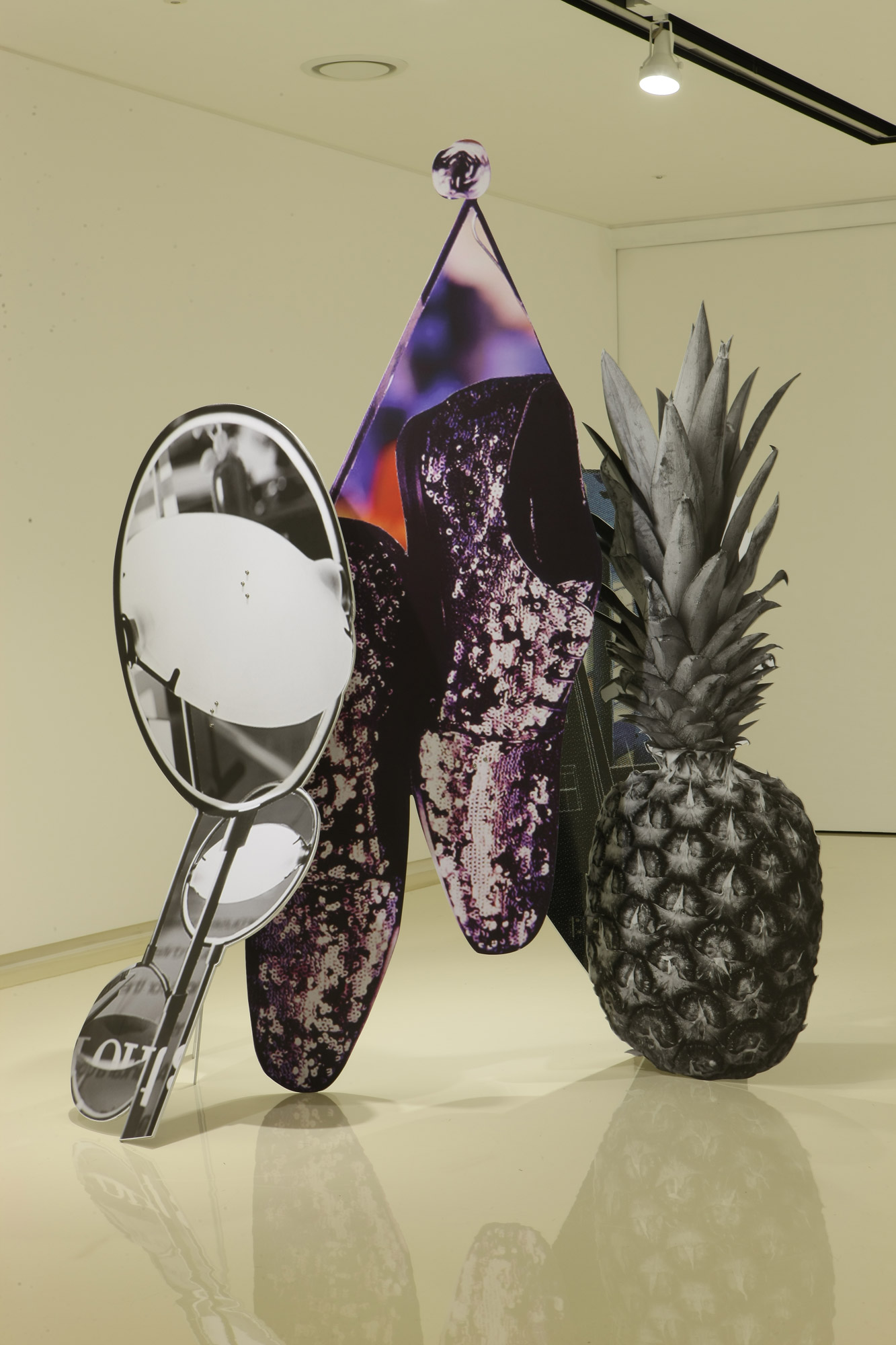 뉴 스트럭처 2 신발과 파인애플 New Structure 2 Shoes and Pineapple 잉크젯프린트, 알루미늄 Inkjet Print, Aluminum 110 x 180 x 197 cm 2014
뉴 스트럭처 2 신발과 파인애플 New Structure 2 Shoes and Pineapple 잉크젯프린트, 알루미늄 Inkjet Print, Aluminum 110 x 180 x 197 cm 2014
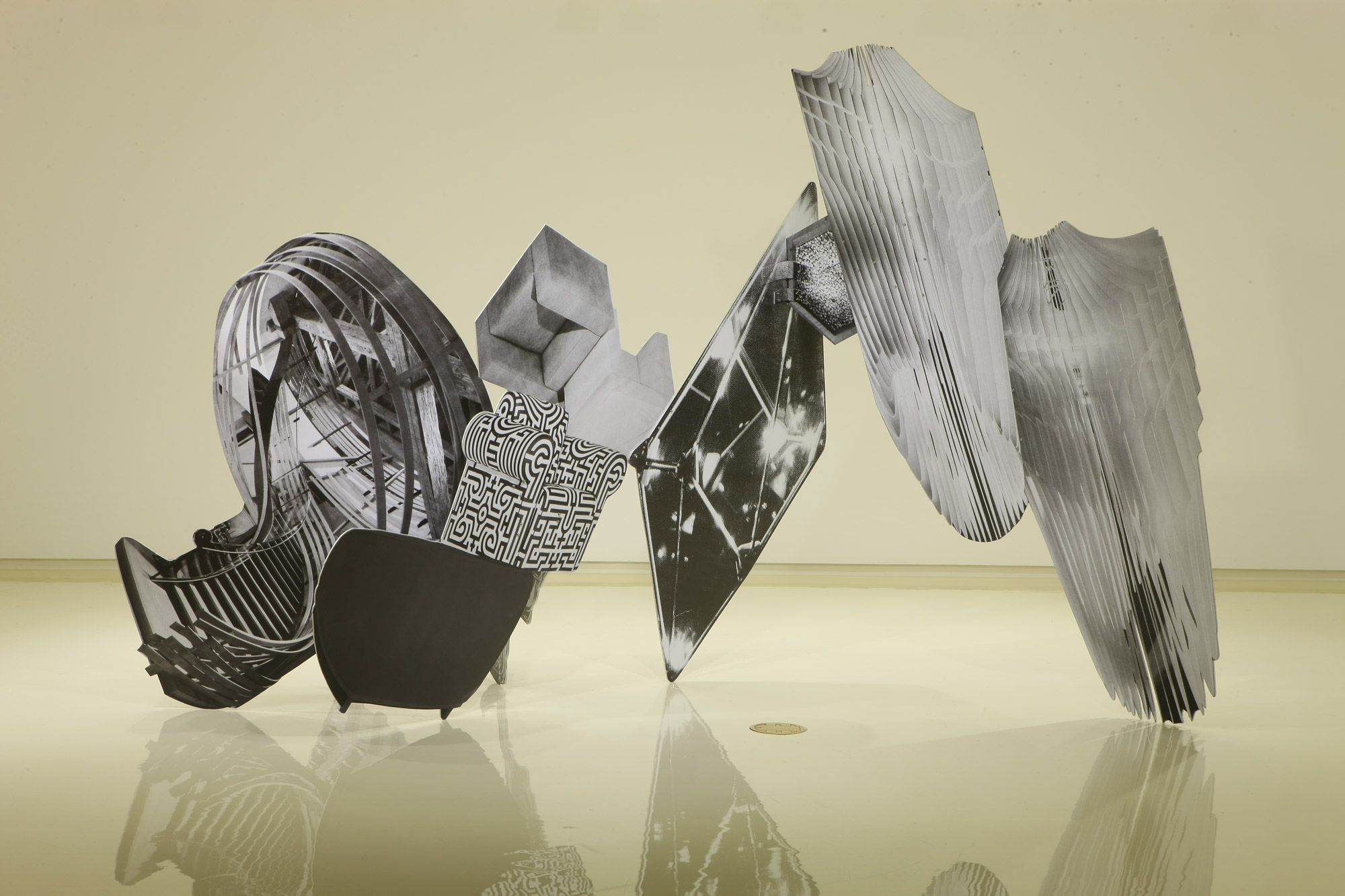 뉴 스트럭처 1 램프와 계단 New Structure 1 Lamp & Stairs 잉크젯프린트, 알루미늄 Inkjet Print, Aluminum 214 x 350 x 165 cm 2014
뉴 스트럭처 1 램프와 계단 New Structure 1 Lamp & Stairs 잉크젯프린트, 알루미늄 Inkjet Print, Aluminum 214 x 350 x 165 cm 2014



